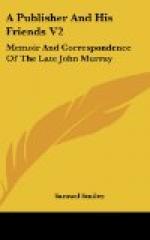Like most sagacious publishers, Murray was free from prejudice, and was ready to publish for all parties and for men of opposite opinions. For instance, he published Malthus’s “Essay on Population,” and Sadler’s contradiction of the theory. He published Byron’s attack on Southey, and Southey’s two letters against Lord Byron. He published Nugent’s “Memorials of Hampden,” and the Quarterly Review’s attack upon it. Southey’s “Book of the Church” evoked a huge number of works on the Roman Catholic controversy, most of which were published by Mr. Murray. Mr. Charles Butler followed with his “Book on the Roman Catholic Church.” And the Rev. Joseph Blanco White’s “Practical and Internal Evidence against Catholicism,” with occasional strictures on Mr. Butler’s “Book on the Roman Catholic Church.” Another answer to Mr. Butler came from Dr. George Townsend, in his “Accusations of History against the Church of Rome.” Then followed the Divines, of whom there were many: the Rev. Dr. Henry Phillpotts (then of Stanhope Rectory, Durham, but afterwards Bishop of Exeter), in his “Letter to Charles Butler on the Theological Parts of his Book on the Roman Catholic Church”; the Rev. G.S. Faber’s “Difficulties of Romanism”; and many others.
While most authors are ready to take “cash down” for their manuscripts, there are others who desire to be remunerated in proportion to the sale of their works. This is especially the case with works of history or biography, which are likely to have a permanent circulation. Hence, when the judicious Mr. Hallam—who had sold the first three editions of “Europe during the Middle Ages” to Mr. Murray for L1,400—had completed his “Constitutional History of England,” he made proposals which resulted in Mr. Murray’s agreeing to print and publish at his own cost and risk the “Constitutional History of England,” and pay to the author two-thirds of the net profits. And these were the terms on which Mr. Murray published all Mr. Hallam’s subsequent works.




